Mission: Impact podcast & blog
Build a better world without becoming a martyr to your nonprofit cause
Listen on:
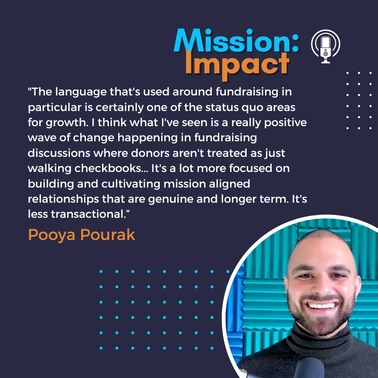 In episode 93 of Mission: Impact, Carol Hamilton and Pooya Pourak discuss the importance of transparent, impact-centric fundraising, the use of technology for efficiency, and the necessity of fair compensation for nonprofit employees. They delve into the nuances of donor engagement, exploring how to shift from a scarcity mindset to one of abundance and collaboration. They also discuss the potential of AI in the sector, while maintaining the human element that is essential to nonprofit work. Episode Highlights: 09:40 - Donor Engagement and Trust: Pooya presents statistics on donor engagement and trust, highlighting the disconnect between nonprofits and donors, and the strategies to improve transparency and communication. 12:00 Language and Fundraising: The conversation shifts to the language used in fundraising and how it affects donor relationships. They discuss the importance of genuine, mission-aligned connections over transactional interactions. 14:00 Shifting Status Quo Assumptions: Carol and Pooya discuss how nonprofits can break free from counterproductive practices and adopt strategies that promote long-term sustainability and diversified fundraising sources. 16:30 Nonprofit Ecosystem Complexity: Pooya reflects on the complexity of the nonprofit ecosystem, including the roles of various stakeholders, from other nonprofits to donors, foundations, and policy. 22:00 Testing Hypotheses in Fundraising: Pooya details the testing of two hypotheses aimed at increasing generosity and online giving, including the influence of unrestricted donations and the effectiveness of matching gifts. 31:00 The Future of the Nonprofit Sector: Looking ahead, Pooya anticipates the growing role of AI in the sector and emphasizes the need to balance technological advances with maintaining the sector's human-centered approach. 34:00 Fair Compensation The interview concludes with Pooya advocating for fair compensation in the nonprofit sector and encouraging a shift from competition to collaboration to enhance collective impact. Guest Bio:
Pooya Pourak Pooya is co-founder and CEO of MatchNice, a social impact tech startup on a mission to connect the nonprofit ecosystem and maximize social impact. His team is working on a new kind of impact-centric fundraising platform to increase transparency, engagement and accountability in digital fundraising. Pooya brings 15+ years of experience leading digital transformation across business, government, and now the nonprofit sector. He is the Host and Producer of The Nonprofit Lab, a podcast dedicated to the journey of discovery in the nonprofit sector with an aim to uncover and shake up the status quo. Pooya runs his own consulting practice where he helps our government listen to the needs of diverse stakeholders and put their feedback into action to inform large-scale systems delivery. Pooya holds a Bachelor of Science from Georgia Institute of Technology in Industrial & Systems Engineering and is also a certified yoga instructor. Important Links and Resources: https://www.matchnice.org/ https://www.linkedin.com/in/pooyapourak/ Charity Vest https://www.charityvest.org/ Google for Nonprofits https://www.google.com/nonprofits/ Click "Read More" to view a transcript of the interview. 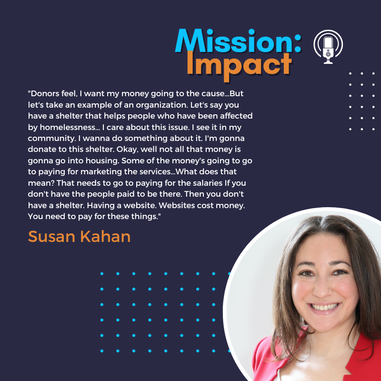 In this podcast episode, Carol Hamilton and Susan Kahan discuss the importance of donor trust and nonprofit accountability. They challenge misconceptions about fundraising, such as the focus on overhead costs and the belief that it is a necessary evil. They argue for reframing negative attitudes towards fundraising in order to build confidence. The conversation also addresses the "overhead myth" in the nonprofit sector and emphasizes the need to invest in staff and create a healthy organizational culture. They discuss the challenges of asking for larger donations and stress the value of building relationships and learning from others in the field. They also highlight the importance of building a culture of philanthropy within nonprofit organizations and using donor feedback to improve programs. Overall, the conversation emphasizes the need for effective fundraising strategies and the importance of transparency and accountability. Episode Outline:
(00:00:01) Donor Trust and Nonprofit Accountability (00:06:05) The Overhead Myth (00:12:19) Building Confidence in Fundraising (00:18:07) Building Relationships in Fundraising (00:24:13) Building a Culture of Philanthropy (00:30:47) The Challenges of Nonprofit Fundraising 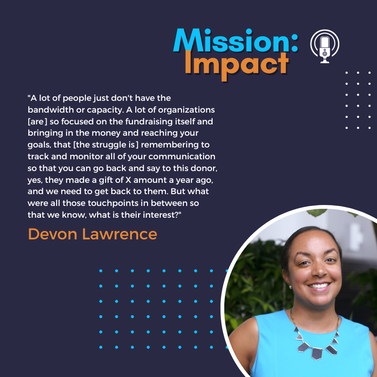 In episode 76 of Mission: Impact, Carol Hamilton and Devon Lawrence discuss
Guest Bio: Devon Lawrence is the Founder and Principal of Clark Lawrence Consulting, Inc. For 10+ years she has worked with non-profits of all sizes, both domestic and international, to advance their capabilities around development operations, fundraising events, project management and leadership. Her clients have praised her ability to be well attuned to the needs, opportunities, and challenges of non-profit organizations and her reliability as a source of guidance on fundraising and organizational development. Devon currently serves on the boards of the Bowery Residents' Committee (BRC) and Association of Nonprofit Specialists. She lives in New York City with her husband and two-year old son. Important Links and Resources:
Click "Read More" for Transcript: 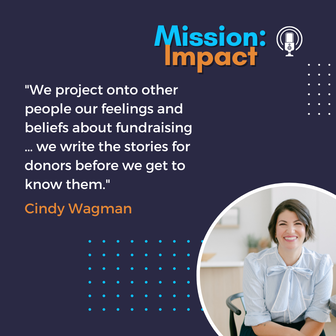 In episode 73 of Mission: Impact, Carol Hamilton and her guest, Cindy Wagman discuss:
Guest Bio: Cindy Wagman is the President & CEO of The Good Partnership. She helps small nonprofits raise more money and reluctant fundraisers learn to love fundraising. Important Links and Resources:
Click "Read More" for Transcript: 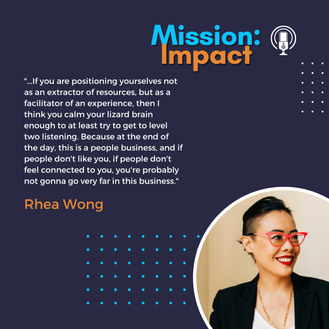 In episode 67 of Mission: Impact, Carol and her guest, Rhea Wong discuss:
Rhea helps nonprofits raise more money. Though she has deep experience with institutional, corporate and event fund-raising, she is passionate about major individual donors and helping organizations to establish individual giving programs. She has raised millions of dollars in private philanthropy and is passionate about building the next generation of fundraising leaders. She has become a leader in the New York nonprofit community and is a frequent educational commentator in the media. She has been recognized with the SmartCEO Brava Award in 2015 and NY Nonprofit Media’s 40 under 40 in 2017. Rhea lives in Brooklyn with her husband. When she is not raising money for causes she loves, she can be found hosting her podcast, Nonprofit Lowdown, promoting her newest book Get that Money, Honey! or onstage as a newbie stand-up comedian in downtown Brooklyn. Important Links and Resources:
Click "Read More" for Transcript: |
Archives
April 2024

Grace Social Sector Consulting, LLC, owns the copyright in and to all content in and transcripts of the Mission: Impact podcast, as well as the Mission: Impact blog with all rights reserved, including right of publicity.
|
Telephone301-857-9335
|
info[at]gracesocialsector.com
|
Grace Social Sector Consulting, LLC, owns the copyright in and to all content in, including transcripts and audio of the Mission: Impact podcast and all content on this website, with all rights reserved, including right of publicity.
|